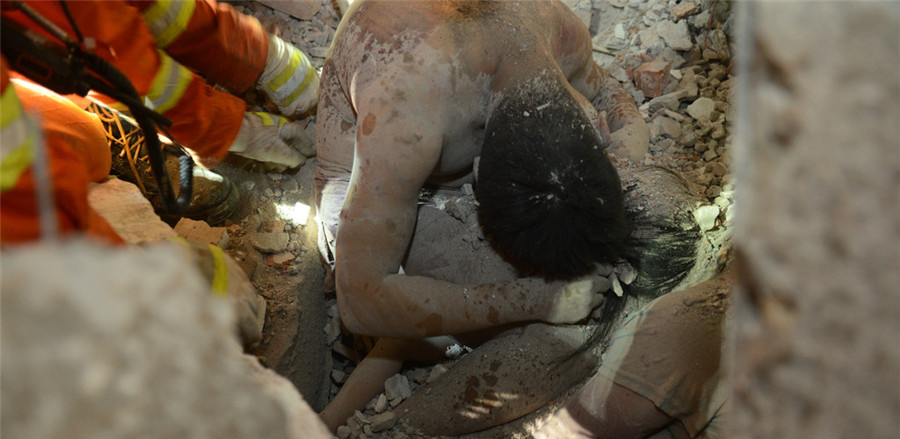
III. Safeguarding the Rights of Specific Groups
The poor population in such specific groups as women, children, the elderly, the disabled and ethnic minorities are the focus of poverty reduction. Since 2012, the Chinese government has increased support for these groups in policy priorities to ensure their rights to social security, health, education and other services are effectively protected.
Protection of impoverished women's rights has been enhanced. The government has carried out the Program for the Development of Chinese Women (2011-2020), formulating and implementing policies and measures to protect poor women's rights and interests. It has strengthened education and training for women in poor areas, training more than 2 million women in rural areas of central and western regions of China. The government has implemented the small-loan guarantee program and a financial interest discount policy for women to encourage urban and rural women to find employment or start businesses. The government conducts a campaign of free breast and cervical cancer screening ("two cancers screening") for rural women every year which covers 532 impoverished counties, offering free breast cancer screening for 10 million rural women and cervical cancer screening for 1.2 million rural women. From 2011 to 2015, the central lottery public welfare fund provided RMB400 million in carrying out such public welfare projects as "treating poor mothers with breast and cervical cancers," "affordable housing for mothers," and "mothers' health express," through which it had helped poor single mothers and poor women who were sick to achieve better lives and better prospects for development. The government has established and improved a new social relief system to enhance the protection of poor women. In 2015, 71.22 million people around China received subsistence allowances and relief and assistance to support those in extreme poverty. Among these, 26.094 million were women, accounting for 36.6 percent of the total. In this way, those who qualified all received assistance and help.
Protection of poor children's rights has been enhanced. The government has formulated and carried out the Program for the Development of Chinese Children (2011-2020) and the National Program for the Development of Children in Poor Areas (2014-2020), improving the system of care services for "left-behind" children (see note) and the mechanism of classified services for children living in difficult circumstances, providing them with rescue and protection.
[note: Children who remain at home while their parents travel as migrant workers to pursue employment.]
The government has implemented the Opinions of the State Council on Strengthening Care and Protection of Rural Left-Behind Children. In this process, it has advanced the building of "children's homes" and "children's happy homes" in urban and rural communities, based on which 158,000 care service actions have been carried out around China, benefiting 13.13 million "left-behind" children. The government has carried out the Opinions of the State Council on Strengthening Care and Protection of Children in Difficulty. During the process, local governments have introduced measures of classified management of children in difficulty, under which, based on the needs and characteristics of different groups, standards are set by category and measures are enforced based on these standards to increase the level of guarantee for children living in difficulty.
The government has implemented the Opinions of the State Council on Strengthening Care and Protection of Orphans, on the basis of which a nationwide subsistence allowance system for orphans and a living allowance system for HIV-affected children have been established. To this end, the central government allocates RMB2 billion every year, ensuring the basic life needs of more than 500,000 orphans and HIV-infected children and making institutional arrangements concerning their medical care, education, and rehabilitation, and their employment, housing and other needs when they grow up.
The government has launched the National Tomorrow Program on Surgery and Rehabilitation for Orphans with Disabilities, with an accumulated fund of RMB860 million, offering free surgery and rehabilitation services to 90,000 orphans, abandoned babies, and poor children.
The government has implemented the Opinions of the General Office of the State Council on Strengthening Rescue and Protection of Homeless Minors, launching special campaigns to "send street children home" and "help street children back to school," while striving to ensure that no minors are used for begging or forced or tricked into begging. It has also extensively introduced an appropriate and all-inclusive welfare and service system for children and carried out experimental work on encouraging social protection of minors, and promoted the establishment of a system for rescuing and protecting minors and a children's welfare and protection network at the county, township and village levels. Since 2011, more than half of China's counties have implemented a program of nutrition improvement for rural students receiving compulsory education, offering a nutritious meal allowance of RMB4 per day per student in impoverished areas; the central government has input a total of RMB67 billion benefiting 33.6 million rural students. Since 2012 the government has carried out a nutrition improvement program for children in poor areas, providing free nutrition packages to infants aged six to 24 months, and popularizing knowledge on healthy feeding among guardians and improving their family education; by this method it has promoted healthy growth and development of infants and young children in poor areas. In 2015, the central government allocated specialized subsidies of RMB500 million to this program, benefiting 2.11 million children in 341 counties in 14 contiguous impoverished areas in 21 provinces, autonomous regions and municipalities directly under the central government.
System for protecting the rights of the elderly has been improved. The government has actively promoted the reform of the old-age insurance system, strengthened old-age services in rural areas, and established and improved a subsidy system for old-age services. In 2009 it started pilot work on new rural social old-age insurance; in 2011 it started pilot work on social old-age insurance for urban residents; in 2014 it established a unified old-age insurance system for urban and rural residents nationwide. In 2015, the central and local governments provided RMB204.4 billion to guarantee and improve the basic life needs of hundreds of millions of elderly urban and rural residents. By the end of 2015, the number of insured around China had reached 505 million, 148 million people had received insurance payments, 95 percent being rural residents; there were 27,248 homes for the elderly with 2.49 million beds in rural areas; day-care services covered more than 50 percent of rural communities; and a system of old-age service subsidies for the elderly in financial difficulties had been established in 20 provinces and equivalent units, while a system of nursing subsidies for disabled elderly had been set up in 17 provinces and equivalent units.
Better rights for persons with disabilities. In 2012 the General Office of the State Council issued the Outline of Development-oriented Poverty Reduction for Rural Persons with Disabilities (2011-2020), emphasizing that poor disabled people are key targets of poverty alleviation. In 2015 the State Council issued the Opinions on Accelerating the Process of Persons with Disabilities Toward a Comparatively Well-Off Life, outlining a series of important measures in three key fields for persons with disabilities: (1) basic livelihood; (2) employment, entrepreneurship and income growth; and (3) basic public services. In 2015 the Opinions of the State Council on Establishing a Full Scale System of Living Subsidies for Disabled Persons with Financial Difficulties and Nursing Subsidies for Persons with Serious Disabilities came into effect. It was the first national system of welfare and subsidy for persons with disabilities. Through targeted surveys, the government has obtained basic information on more than 26.6 million named and identified disabled persons with certificates and more than 700,000 communities providing public services for the disabled, thus managing to provide accurate services for persons with disabilities based on reliable data support.
Since 2012, the central government has arranged RMB3.74 billion of discount loans for rehabilitation and poverty alleviation of 219,000 poor persons with disabilities. It has provided vocational training for 1.45 million persons with disabilities, and as a result 1.24 million urban residents with disabilities have found employment. In 2015, a national platform of online employment services for persons with disabilities was launched. With government subsides, 1.18 million households of poor rural persons with disabilities have seen their homes renovated, 3.17 million poor rural persons with disabilities have received practical technical training, and 4.96 million poor rural persons with disabilities have been lifted out of poverty. As a result of these initiatives, poverty resulting from disability has been effectively reduced.
As of the end of 2015, a total of 10.89 million urban and rural residents with disabilities had been covered by subsistence allowances, nearly 22.3 million persons with disabilities were covered by social old-age insurance for urban and rural residents, and 3.02 million persons with disabilities were covered by basic medical insurance for urban residents.
Poverty eradication for ethnic minority groups has been accelerated. The government has developed a series of special support policies to accelerate poverty eradication for ethnic minority groups and regions inhabited by ethnic minorities. The Outline for Development-oriented Poverty Reduction for China's Rural Areas (2011-2020) maps out 14 contiguous impoverished areas, 11 of which are in ethnic autonomous areas, and 592 key counties for national development-oriented poverty alleviation work, 263 of which are in ethnic autonomous areas. Of the 30,000 poor villages mapped out in the 12th Five-Year Plan for whole-village development-oriented poverty alleviation, 13,158 are in ethnic autonomous areas. From 2012 to 2015, the central government allocated development funds of RMB14.59 billion for ethnic minority groups to advance a special campaign of developing border areas and improving local people's lives, to support development of ethnic minority groups with a small population, and to protect and develop ethnic minority villages with special features and traditional handicrafts. The central government has worked out a budget to inject RMB5.5 billion to support border areas and areas inhabited by ethnic minority groups with a small population in infrastructure construction, in improving local working and living conditions, and in developing social programs. During the 12th Five-Year Plan period, the impoverished population of the five autonomous regions (Inner Mongolia, Guangxi, Tibet, Ningxia, and Xinjiang) and the three provinces with concentrated ethnic minority groups (Guizhou, Yunnan and Qinghai) had dropped from 39.17 million in 2011 to 18.13 million, a decrease of 21.04 million, down 53.7 percent. The poverty incidence declined from 27.2 percent to 12.4 percent, down by 14.8 percentage points.








